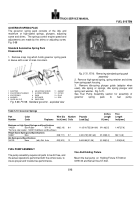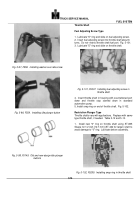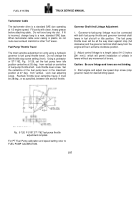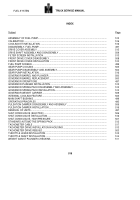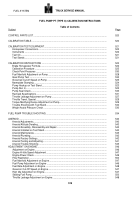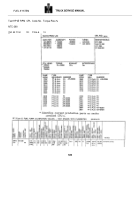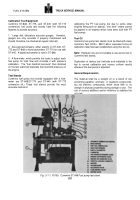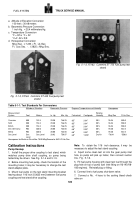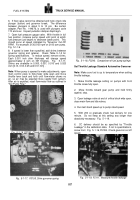TM-5-3805-254-14-P-2 - Page 527 of 894
TRUCK SERVICE MANUAL
to the discretion of the supplier.
The additives must be
antifoaming, anti corrosive antigumming.
The fuel,
additives, and color dye must be non-toxic and non-
harmful to personnel.
Chemical And Physical Requirements
Kinematic Viscosity at
100 deg F Centistokes, ASTM D445.
...................
2.5 3.3
Viscosity at 100 deg F [38 deg C] Saybolt Universal
(SUS), ASTM D2161 .
.......................................
34.4 37.0
Specific Gravity at 60 deg. F, ASTM D287.
........
820.830
Gravity, Degrees API, 60 deg F, ASI M D287.
.......
41-39
Flash Point, P.M., Closed Cup, ASTM D93 160 deq F Min).
Color, ASTM D1500 .
............................................
2 Max.
Water ASSTM D01796.
............................................ .
005
Corrosion, ASIM D130.
......................
Must Pass Class 1
Galvanic Corrosion, ASTM-5322-1 .
...............
Must Pass
Sulphur % Weight, ASTM-P129, D1552 .
...................
0.4
Distillation at 20% point, ASTM-D86 .
.....
440 deq. F Min,
Sediment - Using a 10 Micron filter, 22,260 particles per
millileter are permissible.
Using a 40 Micron filter, 195
particles per millileter are permissible.
Using a 50
Micron filter, 5 particles per millileter are permissible.
Mobile Oil Company Type MC L-41 is one source that
meets the above requirements.
Instruments
A fuel pump cannot be calibrated with any greater
precision than that of instruments on the test stand.
Pressure, speed and flow measurements must be very
accurate, since these are the factors which determine
the pump characteristics.
The instruments on a fuel pump test stand and engine
test stand have the accuracy required for precision
calibration and testing when new, but this accuracy must
be periodically checked and maintained.
General
CAUTION
Cummins Engine Company, inc.
assumes no
responsibility of damage if fuel pump is calibrated to a
different specification than listed for a specific engine
model and Pump Code.
Formula to Determining SAE Brake Horsepower
Evaluation of engine performance during testing is for
the most part, based on accurate horsepower readings.
Therefore, it is imperative that the following formulas be
used with test procedures.
The basic formula to
determine brake horsepower is as follows:
Brake Horsepower = Torque In (Ft.
Lbs.) x Engine RPM
5252
Most engine dynamometer manufacturers provide a
figure known as a "brake constant" with each
dynamometer.
The constant simplifies the process of
computing brake horsepower since only engine rpm and
the scale reading (in pounds) need be found by the test
mechanic.
The formula used with a known constant Is
Brake Horsepower = Lbs.
(on Dyno.
Scale) x Engine
RPM
Dynamometer Constant
Example: Dynamometer in operation has brake constant
of 500.
Scales show a reading of 50 pounds and
tachometer shows engine rpm of 1600.
Brake Horsepower = 50 x 1600 = 160
500
The above formulas apply to engine dynamometers only.
Where chassis dynamometers are used, a factor of
approximately 25% must be used to compensate for
gear ratios, tire size, etc.
Procedures of Converting Horsepower
1.
All horsepower ratings In fuel pump data are
Cummins test ratings.
Cummins test horsepower ratings
are made at 500 ft.
[152 m] altitude and 80 deg, F [26.7
deg.
C] temperature, therefore, test horsepower is about
4% below the ratings made at sea level and 60 deg.
F
[15.6 deg.
C].
To convert sea level horsepower ratings
to your location (see Table 5-1-1) deduct 3% per 1000 ft.
[305 m] above Sea Level and 1% per 10 deg.
above 60
deg.
F [15.6 deg. C].
Notes
:
a.
Turbocharged
engines
develop
the
stated
horsepower from sea level to the altitude given in engine
operators manuals.
b.
All engines derated in power only, or in power and
speed combined, need not be converted for any
difference between Cummins and Sea Level standards.
2.
Data given in Table 5-1-1 is Intended as a guide to be
used In the conversion of horsepower as expressed in
one system to that of another system.
Standard test
conditions vary from one system to another as noted.
Note
: The Din (German) horsepower ratings includes fan
horsepower whereas the other systems listed do not
include the horsepower required to drive the engine
cooling fan or the battery charging generator.
In general,
approximately 10 percent adjustment of horsepower
rating will make up the difference, When the horsepower
required to drive the fan and the generator is known, the
exact adjustment in net horsepower may be made.
3.
Including differences in altitude and temperature in
the standard test conditions, the following conversion
must also be made in addition to the conversion from the
difference in Ft.
Lbs./Sec., so the total conversion
becomes
Cummins, SAE or British HP =
Metric or Din
(German) HP x .9863
Metric or Din (German) HP =
Cummins, SAE or
British HP x 1.0139
Note
: The above conversion disregards the very slight
percent difference in relative humidity between Cummins
and SAE or British systems.
4.
Units of measurement conversions from one system
to another.
522
FUEL SYSTEM
Back to Top

